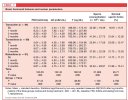Yes, I do. Why would it be invalid merely because homosexuals were included in the research? Regardless, all of the other references stand on their own.
Personally, I think it's more of line than a spectrum, at least with men, but I admit I'm ignorant of any research on the topic. I do think it's very telling though, that when the researcher's drew a bright line and seperated the men into homo and hetero sexual groups, there was a clear-cut contrast, not a non-significant gamut of response. The hetero-sexual men simply did not exhibit any estrogen priming.
this is a technical discussion i won't pretend to be authoritative on, but i do have substantial familiarity with studies on the purported origins of homosexuality. your "bright line" assertion is questionable here, given that the researchers put homosexual men on one side and heterosexual AND "bisexual" men on the other. many on this forum, particularly the jesus-freaks, would call a man who even "dabbled" in homosexual acts to be a closet case. furthermore, many self-reported homosexual men get married to women n repeatedly impregnate them in an attempt to "pass", meanwhile many self-reported "bisexual" men have never had sex with a woman. WHAT WERE THE SELECTION AND DIFFERENTIATION CRITERIA?
there is evidence that in men, increased T will exaggerate their self-reported sexuality (gay men report even more intense n exclusive attraction to men, str8 men report more intense n exclusive attraction to women) whereas increased T in women will make women of any sexual orientation more susceptible to arousal in all categories (ie, lesbians get hornier for women and men, n so do bisexual women and hetero women).
HOWEVER, where do "bisexual" men fit into this
bright-line scenario u describe? n were they 50/50 bi? 8/20 or 20/80 bi? 95/5 or 5/95?
furthermore, the research suggesting "These findings suggest that homosexual males possess, at least in part, a predominantly female-differentiated brain" (i like that weasel wording:
at least in part, a predominantly 
) is itself considered preliminary and incomplete, as other research suggests that some males have scent-receptors geared toward arousal from androgens produced in the sweat of other males.
further still, as i pointed out in a thread of m_ob's some months ago, digit-length research has variously suggested, on one hand, that index fingers substantially shorter than ring fingers indicate a very high androgen exposure in-utero, producing homosexual men and women...
and on the other hand, the same research has been used to suggest that homosexual men have LONGER (or equally long) index fingers than ring fingers, and that heterosexual men have substantially shorter index fingers than ring fingers...and that the greater the difference, the more masculine the male!
i myself have had maybe 3 sexual encounters with females in my almost 38 years of life, all 20+ years ago. besides an occasional twinge in my cock when i see Jessica Simpson jerking a thick microphone toward her mouth like a pornstarlet, i haven't the slightest interest in females. i have a mix of stereotypically male n stereotypically female interests: guns, martial arts, cooking, fashion, music, poetry, physics n astrophysics, interior design. sexually i'm a ferocious hurricane-top and an all-devouring black hole bottom. my ring finger is a full centimeter longer than my index finger.
which side of ur "bright line" would u put me on? is it the same side that these researchers(Dorner, Docke et al.) would put me on? why or why not?


